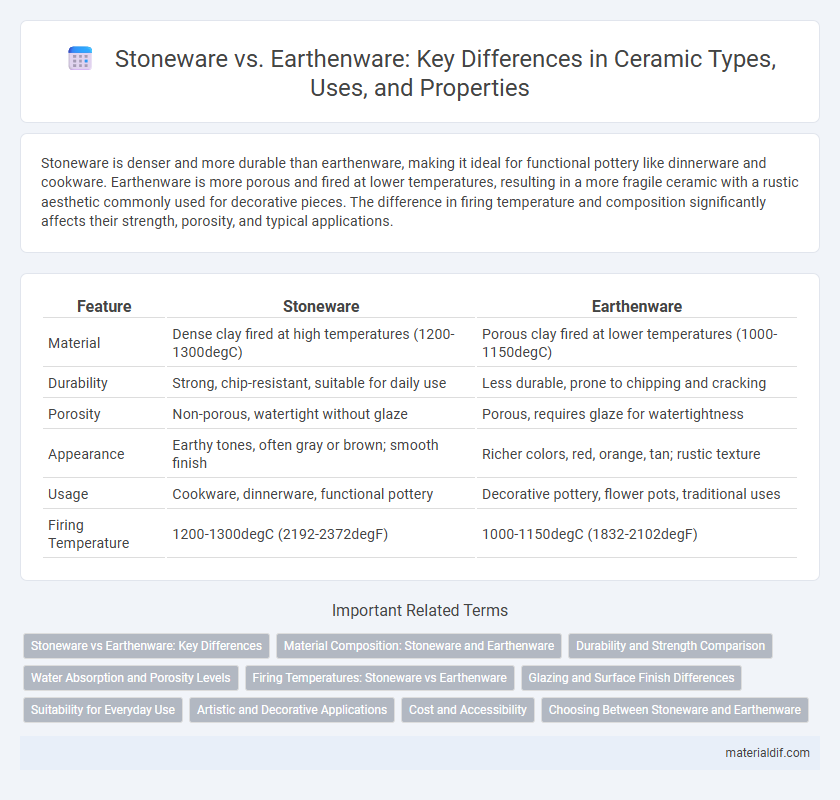Stoneware is denser and more durable than earthenware, making it ideal for functional pottery like dinnerware and cookware. Earthenware is more porous and fired at lower temperatures, resulting in a more fragile ceramic with a rustic aesthetic commonly used for decorative pieces. The difference in firing temperature and composition significantly affects their strength, porosity, and typical applications.
Table of Comparison
| Feature | Stoneware | Earthenware |
|---|---|---|
| Material | Dense clay fired at high temperatures (1200-1300degC) | Porous clay fired at lower temperatures (1000-1150degC) |
| Durability | Strong, chip-resistant, suitable for daily use | Less durable, prone to chipping and cracking |
| Porosity | Non-porous, watertight without glaze | Porous, requires glaze for watertightness |
| Appearance | Earthy tones, often gray or brown; smooth finish | Richer colors, red, orange, tan; rustic texture |
| Usage | Cookware, dinnerware, functional pottery | Decorative pottery, flower pots, traditional uses |
| Firing Temperature | 1200-1300degC (2192-2372degF) | 1000-1150degC (1832-2102degF) |
Stoneware vs Earthenware: Key Differences
Stoneware is a dense, non-porous ceramic fired at high temperatures between 1,100degC and 1,300degC, making it durable and chip-resistant, whereas earthenware is fired at lower temperatures around 1,000degC to 1,150degC, resulting in a more porous and less durable material. Stoneware typically has a vitrified, glass-like surface that is often gray or brown, while earthenware is more porous, softer, and commonly reddish or tan due to iron content. These key differences affect their practical uses, with stoneware preferred for functional dinnerware and earthenware often used for decorative pottery and terracotta items.
Material Composition: Stoneware and Earthenware
Stoneware is made from a dense, non-porous clay fired at high temperatures between 1,200degC to 1,300degC, resulting in durable and vitrified pottery. Earthenware uses a more porous clay fired at lower temperatures, typically between 1,000degC and 1,150degC, which makes it less durable and more absorbent. The key difference in material composition affects their strength, porosity, and typical uses in ceramics.
Durability and Strength Comparison
Stoneware exhibits superior durability and strength compared to earthenware due to its higher firing temperature, typically between 1,200degC and 1,300degC, which creates a denser, vitrified structure. Earthenware, fired at lower temperatures around 1,000degC to 1,150degC, remains more porous and fragile, making it prone to chipping and cracking. The enhanced toughness of stoneware makes it ideal for functional pottery and household items requiring long-term resilience.
Water Absorption and Porosity Levels
Stoneware exhibits low water absorption rates, typically below 2%, due to its dense, vitrified structure, making it highly durable and non-porous compared to earthenware. Earthenware, characterized by higher porosity levels, can absorb between 5% to 8% of water, requiring glazing to enhance its impermeability and strength. The significant difference in porosity impacts usability, with stoneware preferred for functional ceramics exposed to moisture.
Firing Temperatures: Stoneware vs Earthenware
Stoneware is fired at higher temperatures, typically between 1,200degC and 1,300degC, resulting in a dense, vitrified, and durable ceramic body. Earthenware is fired at lower temperatures, usually around 1,000degC to 1,150degC, producing a porous and more fragile material that often requires glazing for water resistance. The difference in firing temperatures directly impacts the strength, porosity, and usability of stoneware versus earthenware in everyday ceramics.
Glazing and Surface Finish Differences
Stoneware features a dense, non-porous surface due to high-temperature firing, allowing for durable, glossy glazing that resists chipping and staining. Earthenware is fired at lower temperatures, resulting in a more porous, rougher surface that requires lead-based or tin glazes to achieve a smooth, often matte or semi-gloss finish. The glazing on stoneware enhances its strength and moisture resistance, while earthenware glazing primarily serves to seal the porous body and add decorative appeal.
Suitability for Everyday Use
Stoneware offers superior durability and resistance to chipping, making it ideal for everyday use in kitchens and dining. Earthenware, while charming with its porous and rustic texture, requires more careful handling and is often glazed to prevent moisture absorption. Stoneware's ability to withstand higher temperatures and frequent washing enhances its practicality for daily meals.
Artistic and Decorative Applications
Stoneware offers greater durability and a denser composition, ideal for intricate sculptural pieces and functional art with a smooth, vitrified finish. Earthenware's porous and slightly coarse texture suits vibrant glazes and detailed decorative motifs, often used in traditional pottery and ornamental ceramics. Artists favor stoneware for longevity and strength, while earthenware is preferred for colorful, expressive surface treatments that highlight artistic creativity.
Cost and Accessibility
Stoneware typically costs more than earthenware due to its higher firing temperatures and durability, making it a long-term investment for functional pottery. Earthenware is more accessible and affordable, favored for decorative items and beginner ceramics because of its lower production costs and widespread availability. Both materials offer unique benefits, but budget constraints and project requirements often guide the choice between them.
Choosing Between Stoneware and Earthenware
Choosing between stoneware and earthenware depends on durability and usage needs; stoneware is fired at higher temperatures, making it more durable, non-porous, and suitable for everyday use and oven-to-table applications. Earthenware, fired at lower temperatures, offers a porous and lightweight option ideal for decorative pieces or low-impact functional ware but requires sealing to prevent absorption. Consider stoneware for robust, chip-resistant crockery and earthenware for artisanal aesthetics with gentle handling.
Stoneware vs Earthenware Infographic

 materialdif.com
materialdif.com